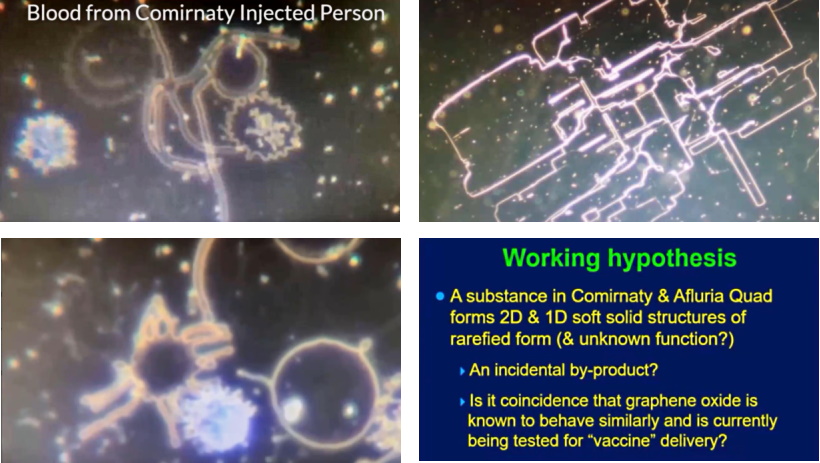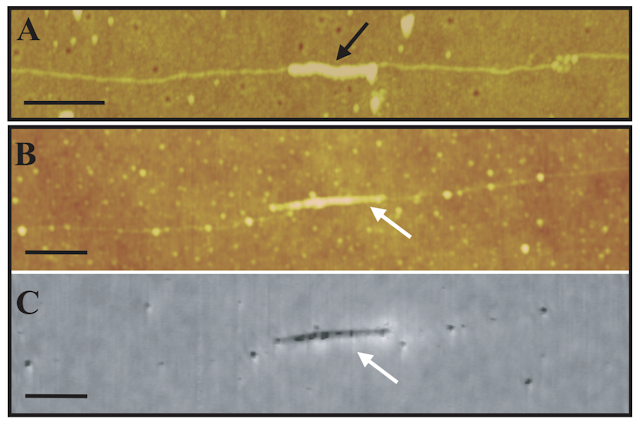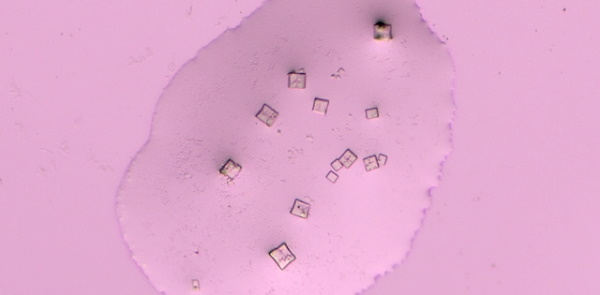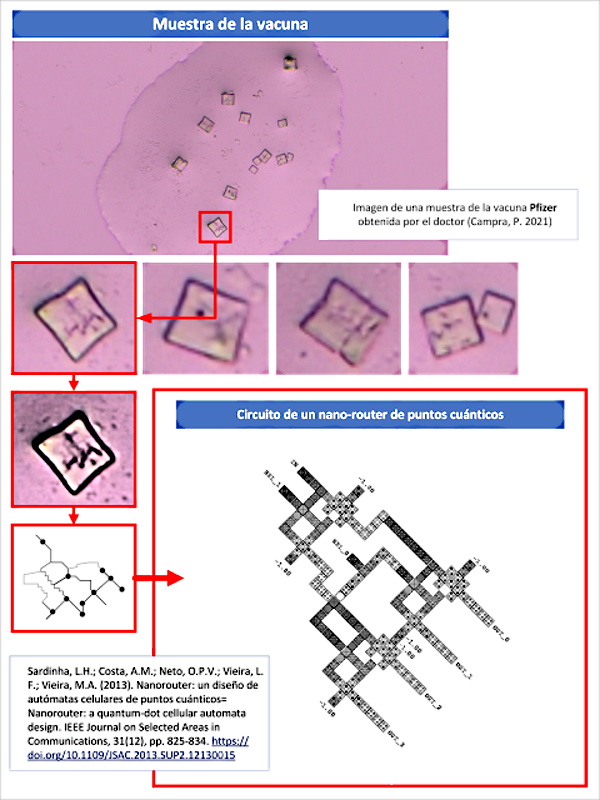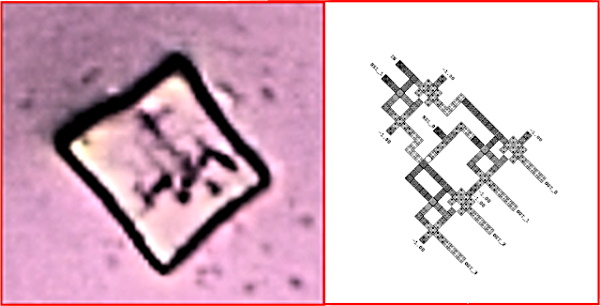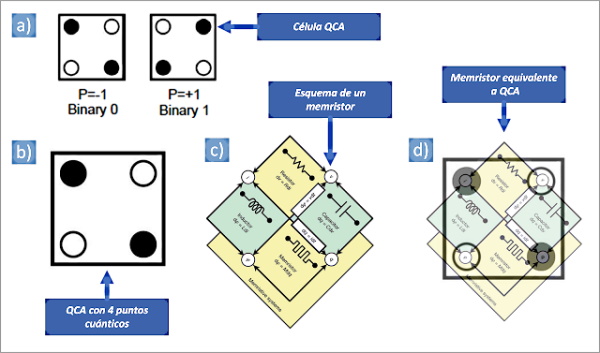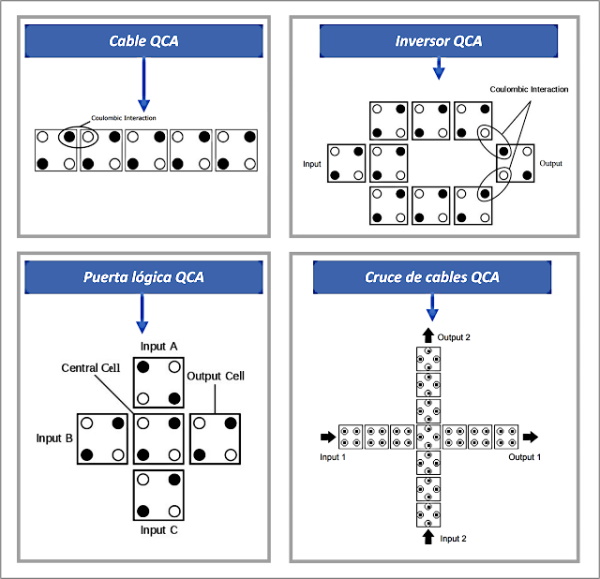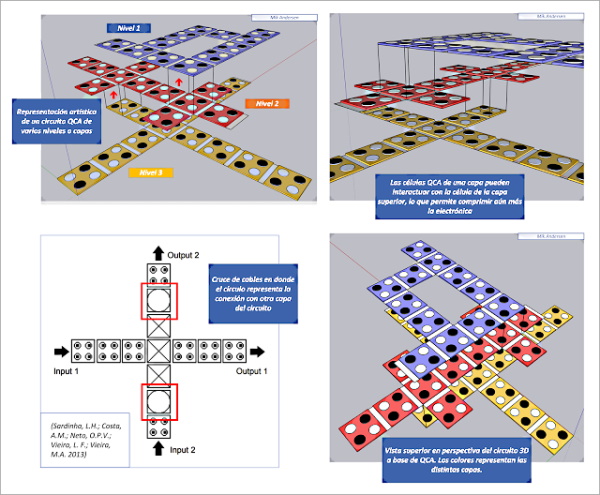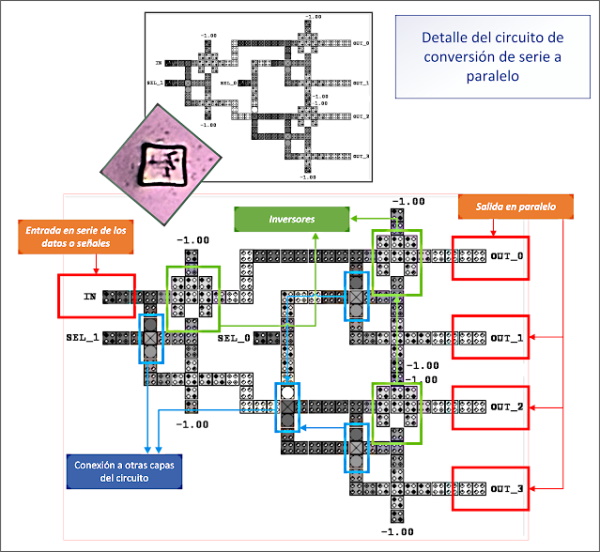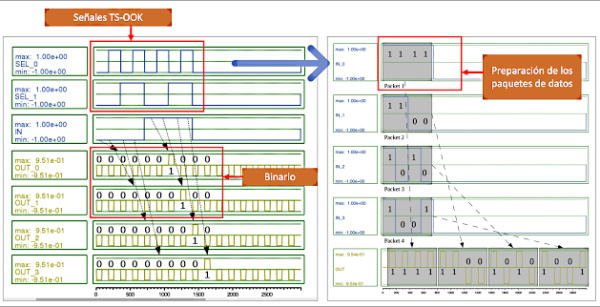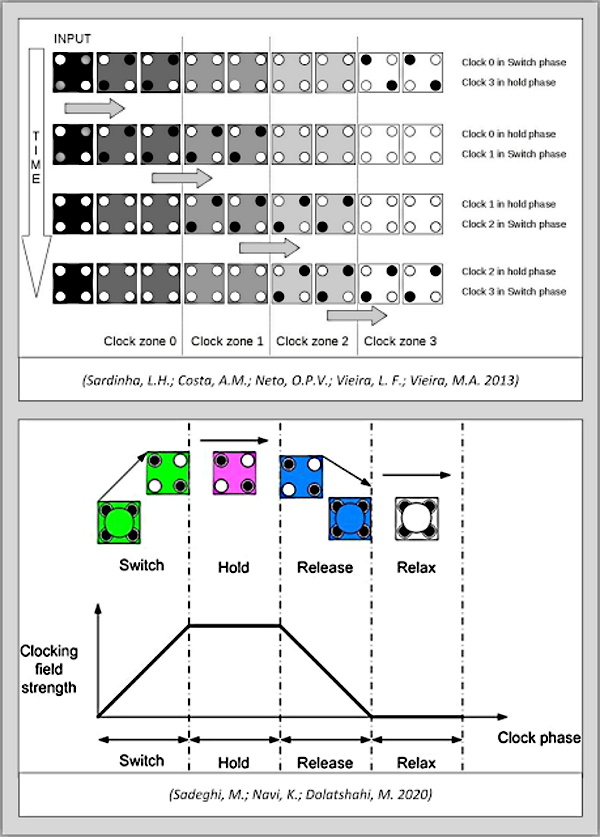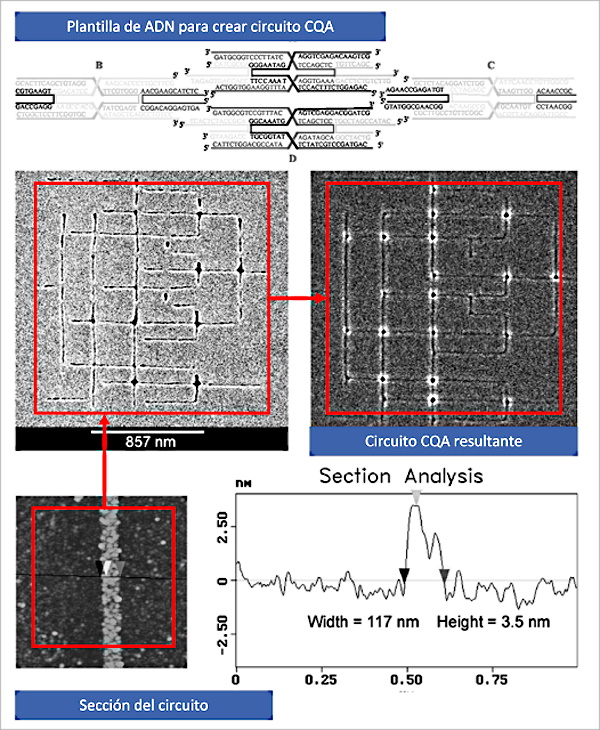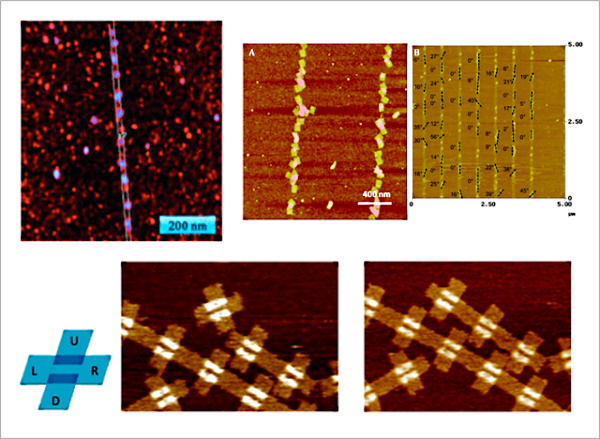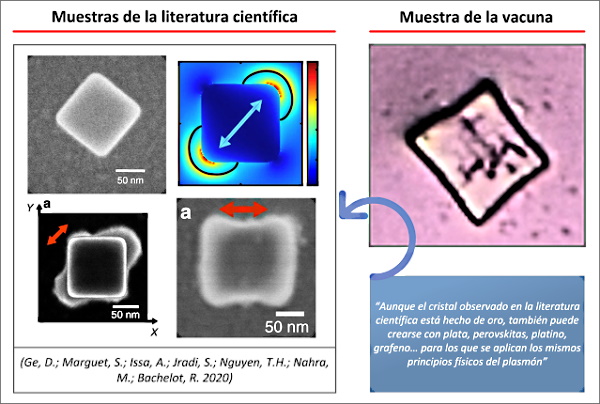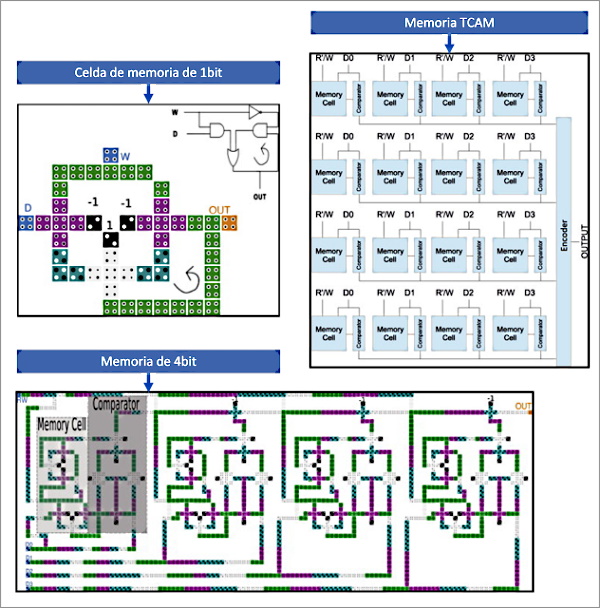Contamination of Agricultural Soils and Plants, Terrestrial and Aquatic Environments, by Graphene in Fertilizers and Pesticides of Toxic Agriculture
Contamination of Agricultural Soils and Plants, Terrestrial and Aquatic Environments, by Graphene in Fertilizers and Pesticides of Toxic Agriculture
by Dominique Guillet, Xochipelli
published March 11, 2023
Summary [Topics Covered in This Article] :
-
Foreword
-
Nano-materials of the Graphene family are strictly unregulated by the European Commission
-
How long have Graphene derivatives been contaminating Agriculture? Ten years or fifteen years?
-
Graphene Hydrogels commercialized for Agriculture
-
Studies on the toxicity of Graphene derivatives on plant growth and soil health
-
Studies on the toxicity of Graphene derivatives on all elements of aquatic environments
-
Studies on the ability of Graphene derivatives to allegedly improve plant growth
-
Studies on the ability of Graphene derivatives to eliminate or mitigate, allegedly, toxicities or pests in agriculture
-
A few Patents concerning the insertion of graphene oxide in Fertilizers and in Pesticides/Biocides of all kinds
Foreword
This dossier is a follow-up to my first one, entitled “Graphene in Agriculture”, which presented two of my short articles on the subject, as well as six essays written by the Spanish researcher, Mik Andersen. This first dossier was presented in January 2022.
In this present dossier, I have “restricted myself”, in the first part, to the proven contamination of agricultural plants, agricultural soils, terrestrial environments and aquatic environments, by Graphene present in fertilizers and pesticides used in Agriculture. I do not address the same “contamination”, by Graphene as a “decontamination vector”, of these same agricultural, terrestrial and aquatic environments… which it has itself contributed to contaminate in synergy with a host of other metallic nanoparticles. This scandalous issue of the “decontamination by Graphene” will be the subject of a subsequent dossier.
The situation is much more serious than the Spike’s Wacky Sectarians, and other devout dissidents of the Covidian religion, can imagine, when they censor us, inexorably, we whistleblowers who denounce the presence of graphene, nano-particles and other nano-technologies, in CoYid/19 injections – and other injections called infantile, anti-flu, anti-cancer, anti-meningitis, “vaccines” – ad nauseam and ad mortem.
Graphene is everywhere: namely, in all sectors of daily life because it is considered the miracle material – especially by all the eugenicist Globalists and other scientists in their pay… Indeed, Graphene will allow them to trace and connect Humans by chaining and imprisoning them, “digitally”, in the nets of the virtual network under the pretext of “digital health”, “digital medicine” or “digital pharmacy” – or under no pretext at all… when dictatorship sets in.
Biologists, doctors, researchers, journalists, activists, columnists, influencers, civil servants, etc., who continue to deny this reality of the omnipresent Graphene – or to deny the extreme health risks associated with this reality of the omnipresent Graphene – are thus invited to open their eyes, their ears and their synaptic connections very quickly… or to change profession. What about plumbing?
Why? Because they are liars and because, today, the empire of lies – and its peddlers under all ideological shades – is in the process of collapsing under the weight of its own inconsistencies, manipulations, dissonances. Indeed, the empire of lies can no longer generate as much energy as it would take to fill the gaps… which are becoming more and more gaping.
In a second part, I present the studies which affirm that Graphene can increase the growth of the plants, fight against the pests or, even, take part in the decontamination of the agricultural plants toxified by the extreme abundance of heavy metals, various and varied, in the agricultural grounds.
Indeed, there are teams of highly paid “scientists” whose mission is to claim that Graphene is harmless in agricultural soils, in food plants, in terrestrial and aquatic environments – and that it is, in fact, beneficial. These are the same people who produce “scientific” studies on the danger of the non-existent CoYid/19 or on the harmlessness of genocidal vaccines.
These are the same people who produce “scientific” studies claiming that Graphene is not dangerous for the human organism – and that it is, in fact, beneficial. In fact, I am presenting, here, summaries of hundreds of studies on the toxicity of Graphene derivatives: graphene oxide, reduced graphene oxide, carbon nanotubes, carbon quantum dots, graphene quantum dots, etc.
It is important to elucidate what a plethora of scientists have been working on, for the last 15 years or so, with regard to the very concrete problem of nano-particles in agriculture – and therefore in food. Indeed, those who finance this type of research and study are, of course, very intentional – in terms of profitability, or, in the case of “vaccines”, in terms of orchestrating planetary depopulation.
This elucidation is all the more essential since, as mentioned below, hundreds of thousands of tons of nano-materials are injected annually into agriculture, in France for example, without anyone being aware of the existence of this phenomenon – or of the nature of the nano-particulate substances injected… under the pretext of fertilizers, elicitors or pesticides.
This is why I am presenting, first of all, the very concrete and commercialized case of the graphene hydrogel, GelPonic, in order to highlight the fact that – just as insect meal has been sneaking into many foods for years – graphene has already infiltrated all sectors of agriculture… and therefore, of food.
It is no longer just a matter of patents or PhD studies… but of concrete proposals made by the industry. Moreover, patents and other scientific studies by PhDs are often only the first signs of an industrial catastrophe.
I invite readers interested in this very toxic issue to consult my very long files on the subject of Graphene in human food through cellular food, insect-based food, functionalized meats, food packaging, etc:
Graphenization of the meat, and proteins, by “vaccines” injected into the livestock
Graphene has infiltrated agricultural plants even more than it is beginning to contaminate all terrestrial and aquatic environments – as many of the following studies have shown. And this is, of course, without dwelling on the Graphenization of the Atmosphere, which I have already addressed in a voluminous dossier, “Graphene in the Atmosphere”.
Graphene in its various forms circulates in the Atmosphere, in agricultural environments, in aquatic environments… and, therefore, in the rivers and water tables that serve agricultural soils – in a vicious circle of self-accumulation and self-assembly.
It goes without saying that the problem of contamination of terrestrial and aquatic environments by graphene present in fertilizers, elicitors and pesticides of toxic conventional agriculture, is also posed for all other metallic or non-metallic nanoparticles that have been used in agriculture for a long time.
What should we do? We will avoid panicking, first of all, because the Globalists already handle panic with brio.
Let us be confident that in the long run – whatever the amplitude – Gaia, our Mother Earth, digests and metabolizes any substance and, one day, she will emanate, from her Biosphere, a bacterium with the capacity to digest all the two-dimensional carbonaceous nano-materials (0.35 nm thick) of the Graphene family… if they excessively disturb Her Natural ways.
Nano-materials of the Graphene family are strictly unregulated by the European Commission
Here is how the European Commission (the tool of the European dictatorship in the service of the military-industrial complex) presents the regulations on nano-materials in three pages – the third of which is extremely clear as to the strict preponderance of derivatives of the Graphene family in the general nomenclature of this class of materials. [91] These regulations are, intrinsically, non-regulations.
It goes without saying that all nano-materials are strictly unregulated by the European Commission – not just graphene derivatives.
«Nanomaterials in REACH and CLP. On 3 December 2018 the Commission adopted Commission Regulation (EU) 2018/1881 to modify REACH Annexes I, III and VI-XII, introducing nano-specific clarifications and new provisions in the chemical safety assessment (Annex I), registration information requirements (Annex III and VI-XI) and downstream user obligations (Annex XII).
… On the basis of the Commission Recommendation of 18 October 2011 on the a nanoform is a form of a natural or manufactured substance containing particles, in an unbound state or as an aggregate or as an agglomerate and where, for 50 % or more of the particles in the number size distribution, one or more external dimensions is in the size range 1 nm-100 nm, including also by derogation fullerenes, graphene flakes and single wall carbon nanotubes with one or more external dimensions below 1 nm.» [86]
Reading this regulation 2018/1881, it is obvious that the European Commission authorizes, blindly, the totality of the nano-particles produced by the Industry because if one refers to its requests of non-toxicity – with regard to humans, invertebrates, algae, etc – it is a long time since a formal, and generalized, prohibition should have been promulgated in order to protect the health of the populations and the eco-systems.
Indeed, only for some graphene derivatives, I have presented about 300 studies proving their extreme toxicity. And these are, for the most part, studies dating from recent years … while the first studies, of toxicity, date from about 2011 – ie, the time of the « recommendation » of the European Commission of October 18, 2011 on the “nano-form” … [87]
How could Graphene be regulated, in terms of its toxicity, when billions of euros of public money are being transferred to all the pseudopods under the aegis of the Graphene Flagship – which, of course, all affirm, with their mouths agape, that Graphene is the miracle material – and so harmless!
How could Graphene be regulated, in terms of its toxicity, when the Globalists are drooling with excitement over the concept of “15 minute cities” promoted by the demented and eugenicist gang of the World Economic Forum?
How could Graphene be regulated, in terms of its toxicity, while the Globalists are drooling with excitement over the concept of “Graphene cities”, the integral Graphene cities? Why? Because graphene is the inescapable, fundamental foundation of the “15-minute cities” so dear to Klaus Schwab.
Graphene is the fundamental vector, present and future, of the Connection, in all its virtual and false aspects. All those who are not able to apprehend, organically, this Reality are, probably, already disconnected from it.
According to the review titled “Hazard characterization of graphene nanomaterials in the frame of their food risk assessment: A review”, and published, in June 2022, in Food and Chemical Toxicology. [93]
«The obtained results showed that the investigations performed up to now did not follow internationally agreed-upon test guidelines. Moreover, GFNs seemed to resist gastrointestinal digestion and were able to be absorbed, distributed, and excreted, inducing toxic effects at different levels, including genotoxicity. Also, dose has an important role as it has been reported that low doses are more toxic than high doses because GFNs tend to aggregate in the digestive system, changing the internal exposure scenario. Thus, further studies including a thorough toxicological evaluation are required to protect consumer’s safety. »
How long have Graphene derivatives been contaminating Agriculture? Ten years or fifteen years?
If we refer to the article, from 2015, presented by Inf’OGM, and entitled « Des nanos en agriculture? », [58] here is what Danielle Lanquetuit and Mathilde Detcheverry of the association AVICENN – whose objective is to promote public debate and the transparency of political leaders on the issue of nanotechnologies – state.
«Thanks to the mandatory declaration instituted by France in order to feed a register (R-Nano) of nano-materials on our territory, created in 2013, we know that nearly 416 000 tons of nano-substances were declared as having been produced or imported in 2014 in France. But this figure is far below the overall volume of nano-materials actually introduced on our territory and which escape the radar of the authorities. For the past two years, agriculture has topped the list of declared sectors, without any indication of either the volume of nano-materials actually used in this sector, or the number of agricultural declarants…
Farmers are unknowingly exposed to the nano-materials in the mixtures they handle and spray... In 2014, we were able to identify at least seven companies that market products for crops that have filled out declarations in R-Nano, with about forty products sold in agriculture… without being able to have more information: the companies indeed do not provide any information on the nano-materials they use, neither in the safety data sheets, nor on their sites nor on the site of the Union of Plant Protection Industries (UIPP).»
The underlining is mine to emphasize that this is a ten year old agricultural issue. What is the nature of these nanoparticles in fertilizers, elicitors and pesticides/biocides in conventional agriculture? Few people know the composition of these nanoparticles because it requires going back upstream… to the trade secrets of the Pharma Industry – which controls the Agro-Chemical Industry.
What we can be sure of is that graphene is everywhere in agriculture because, firstly, its various derivatives have been known for about twenty years; secondly, it is considered to be the miracle material that will revolutionize everything; and, thirdly, for the last few years, it can be produced by the ton – from any carbonaceous bio-mass – at a very minimal cost.
Here is how the organization, called Graphene Council, presents, in May 2022, the new generation of nanoparticle pesticides as conceived by the US EPA, Environmental Protection Agency :
«To meet this need, an EPA research team led by Dr. Su conducted an exhaustive search for patents and published literature related to nanopesticides to understand the state-of-the-science. The team found and analyzed over 36,000 patents and 500 peer-reviewed journal articles. From their research findings, the team established two general categories of nanopesticides to help inform EPA’s regulatory reviews: 1) products with mostly metal-based nanomaterials as the active ingredient, like nanosilver and nanocopper oxide/hydroxide, and 2) products that encapsulate and carry the active ingredient using nanomaterials (mostly carbon based) like graphene and carbon nanotubes.
The team found that nano-enabled pesticides adhere better to plant surfaces and have a reduced impact on non-target organisms. Nanopesticides may also enhance plant resilience against stressors from heat or drought. These benefits could lead to higher crop yield and provide more agricultural resilience to address climate change and weather extremes. The team’s findings also highlight the data gaps and the need for additional research on potential adverse impacts of nanopesticides.» [59]
It is thus very clear to the US governmental environmental protection agency that there are two classes of nano-particulate materials, called « nano-pesticides » in agriculture: on the one hand, active ingredients based on metallic nano-particles and, on the other hand, conventional pesticide carriers, which are all of the Graphene family.
Here, now, is how the platform, named AzoNano, presents, in April 2022, the next generation of graphene-based nanoparticle fertilizers and pesticides: [60]
«In agriculture, carbon-based nanomaterials attempt to decrease the number of pesticides distributed, minimize nutrient leaching in fertilization, and increase pest and disease control output.
Carbon nanomaterials (CNMs) can be used as excellent fertilizer carriers due to their stable molecular arrangement, uniform dispersion, and low toxicity in application media. For example, graphene oxide nanoparticles are effective trace element transporters.
Carbon nanomaterials (CNMs) are utilized as light converters for supplementing plant photosynthesis. Through chloroplast photosynthesis, plants transform solar energy into chemical energy.
The sunlight used by chloroplasts is primarily confined in the blue and red regions of the visible spectrum. Therefore, they can be used as light conversion materials to maximize solar energy for expanding the light spectrum for plant photosynthesis. That said, to use carbon nanomaterials (CNMs) as light converters in plants, some important factors such as light conversion efficiency, biocompatibility, and cytotoxicity of light converting carbon nanomaterials (CNMs) in plants, and heat produced during carbon nanomaterials-enabled light transformation in plants must be taken into account.
Recently, Zhu et al. revealed that carbon-based nanomaterials with antifungal characteristics could be used to generate new fungicides. Among the different carbon nanomaterials (CNMs) tested against two plant pathogenic fungi, including nanotubes, fullerenes, and graphene oxide, the single-walled carbon nanotubes (SWCNTs) had the strongest antifungal action.
The use of carbon nanomaterials (CNMs) in applying biosensors, light convertors, fertilizers, pesticides, and agrochemical delivery is notable. However, their impact may change depending on plant species, carbon nanomaterial (CNM) type, and its dosages.
In agricultural applications, carbon-based nanomaterials can make the following contributions:
Increased agricultural yield with the use of plant growth boosters and innovative nanomaterial-based fertilizers.
Plant protection products based on nanomaterials, such as insecticides and herbicides.
The use of nano-encapsulated plant protection agents and slow-release fertilizers to reduce the number of agrochemicals used.
Nanotechnologies for agricultural practice optimization via precision farming. [60]
Graphene Hydrogels commercialized for Agriculture
In England, researchers at the University of Manchester are working on a new concept, called “Graphene City”, which aims to graphenize all supply chains – and, in fact, all sectors of daily life.
May I repeat that all sectors of daily life, that means: “vaccines”, injections, drugs, aerosols, cosmetics, dressings, condoms, sanitary napkins, therapeutic women’s panties, anesthetics, dental implants, eye lenses, concrete, asphalt, window frames, water treatment membranes, ventilation system filters, fertilizers, agricultural pesticides/biocides, bio-testing shoes, bio-testing clothing, clothing insulation, face masks, wall paints, batteries, electronics, wind turbines, pain relief patches, night covers, mattresses, light bulbs, headphones, ski goggles, etc., etc?
One of their research objectives is to graphenize agriculture. They are, thus, developing an agricultural alternative they have named “GelPonic” in order to, allegedly, reduce energy and space wastage by promoting vertical agriculture. “GelPonic” is a graphene hydrogel that has the ability to “sense” the nutritional needs of plants in the soil and meet them.
This graphene hydrogel is available in the form of granules, plates or blocks. [1]
This research, funded by the UK government and Europe, is under the responsibility of Dr. Beenish Siddique, the founder, and CEO, of AEH Innovative Hydrogel – which is located in the Graphene Engineering Innovation Centre in Manchester. [77]
Their official propaganda is well-smoothed and uses all the key concepts to fool the dumb and the sleepy: “sustainability”, “recycling”, “resilience”, “carbon sequestration”, “water saving”, “corporate social responsibility”, “zero carbon emissions”, etc.
AEH Innovative Hydrogel’s graphene hydrogel is also used for medical applications – in particular to treat chronic wounds, to avoid infections and amputations. [78]
“Connected bandages” are also manufactured by Grapheal in Grenoble, in France – a graphenizing company that also offers a “digital” CoYid/19 saliva test. Grapheal announces itself as “designer and manufacturer of embedded digital biosensors for field medical diagnosis and remote patient monitoring”. [902] [903] The connected bandage is presented as follows: «This smart and connected graphene-based bandage is extremely flexible and adapts easily to all parts of the body. Its tiny wireless electronics with very light and highly flexible electrodes transmit data to a mobile application. Using tele-medicine software and medical technologies in the cloud, the hospital receives the information, which can then be monitored and evaluated by a specialist.»
One study, published in July 2021, even proposes an aerogel composed of graphene oxide and polyethylene glycol reinforced with grape seed extract (for its proanthocyanidins) to heal wounds. [1069]
On the other side of the Atlantic, in California, Juan Pablo Girald – from the University of California Riverside – is leading a $1.6 million funded project on the use of nanotechnology to deliver nitrogen, as a fertilizer, directly into choloroplasts.
UC San Diego, to use nanotechnology, chemized by her team, to deliver genetic material into chloroplasts. According to Nicole Steinmetz, «Our idea is to refunctionalize natural nanoparticles, namely plant viruses, in order to deliver genes into a plant… Some engineering is needed to make sure that the nanoparticles access the chloroplasts and also that they cannot infect the plants.» Their goal is, thus, to have these lettuces and spinach, chimerized in vaccine mRNA, grown by gardeners themselves – or by large-scale market gardeners for city populations.
These researchers specify, with their hand on their heart, that all their researches are oriented towards “ecology” – that is to say the same ecology promoted by Klaus Schwab, the Transhumanist Reinitiator. It is a question of optimizing the delivery of nitrogen to the heart of the cells of cultivated plants in order to avoid its waste – real, namely the direct infiltration, of half of this nitrogen of synthesis, in the water tables.
The question that one must ask oneself, when dealing with these mentally disturbed people: what is the nature of this “engineering”, of chimerization, that must be applied in order for the nanoparticles to reach the chloroplasts. In short, what is the process by which the “refunctionalization” of phytoviruses – that is, of plant-infecting viruses – is carried out?
According to the presentation of a Korean patent, from 2019, on the increase of plant growth by incorporation of graphene nano-particles: « It has been shown that carbon nanotubes, in monofoil, can be transported and deposited, in the lipid bilayer of chloroplasts, through kinetic trapping that promotes photosynthetic activity and electron transfer.» [929]
The other question we have to ask ourselves: could it be a “refunctionalization” with graphene oxide, carbon quantum dots or carbon nanotubes? Would these graphene nanoparticles be used for conveying purposes… in order to access the chloroplasts?
It is very likely that the answer will be of the same type as for the Quantum/19 injections of the Pharmacratic Mafia. The mRNA is wrapped in lipid nanoparticles and nothing more, I promise… And how do we explain, then, the magnetization of some injected?
Thus, as early as spring 2018, the University of Adelaide, Australia, made headlines in the Industrial Fertilization sector by announcing the effectiveness of “eco-friendly” industrial fertilizers, respectful of the environment, because they are vectorized by graphene oxide. [934] [935]
Today, as mentioned above, it is not easy to determine who is marketing nano-fertilizers or nano-pesticides. On the other hand, it is very easy to determine which companies commercially distribute graphene, carbon nano-tubes, fullerenes, carbon nano-cones, carbon nano-pulp, etc., etc. Examples are INSCX [76], NanoIntegris [77], OCSiAl [78], Tuball [79], MKNano [84], Matexcel [83], Platonic Nanotech [82], NanoAmor [81], etc.
The Nanowerk platform presents 53 industrial companies, worldwide, commercializing a plethora of nano-products of the Graphene family. [80]
Studies on the toxicity of Graphene derivatives on plant growth and soil health
“Distribution of different surface modified carbon dots in pumpkin seedlings”. 2018. [16] At the biochemical level, the elevated antioxidant enzymes in pumpkin roots suggest that all the CDs could potentially trigger the antioxidant defense systems in pumpkin seedlings. Additionally, such alteration was greater in the roots than in the shoots. Our study represents a new perspective on CD visualization in plant tissues and provide useful information for the potential toxicity of different types of CDs to terrestrial plants, which is of importance to agricultural application.
“Graphene oxide enters the rice roots and disturbs the endophytic bacterial communities”. [55]
“Identifying the Phytotoxicity and Defense Mechanisms Associated with Graphene-Based Nanomaterials by Integrating Multiomics and Regular Analysis”. 2021. [20]
The results showed that the plant defense was regulated by reducing the calcium content by 21.7-48.3%, intercellular CO2 concentration by 12.0-35.2%, transpiration rate by 8.7-40.2%, and stomatal conductance by 16.9-50.5%….The phytohormone gibberellin and abscisic acid receptor PYL8 were upregulated, indicating the activation of defense systems. However, reduced graphene oxide and graphene oxide quantum dots trigger stronger oxidative stress (e.g., H2O2 and malondialdehyde) than graphene oxide in fruits due to the breakdown of antioxidant defense systems (e.g., cytochrome P450 86A22 and P450 77A1).
“Stress Response and Nutrient Homeostasis in Lettuce (Lactuca sativa) Exposed to Graphene Quantum Dots Are Modulated by Particle Surface Functionalization”. 2021. [2]
C-GQDs and O-GQDs cause oxidative damage, disruption of mineral and organic nutrients homeostasis, impairment of photosynthesis, and modulates the levels of phytohormones. Light-triggered reactive oxygen species generation and oxidation of antioxidants in plants are the critical reason for the phytotoxicity and explain the difference between the different functionalizations. These findings suggest that GQDs may not be as safe as expected. Future studies should consider the modulation of surface chemistry to achieve optimal safety of GQDs, and more plant species should be tested over a longer-term scale.
“Surface charge affects foliar uptake, transport and physiological effects of functionalized graphene quantum dots in plants” 2021. [21]
Overall, our findings provide direct evidence for the influence of surface charge on foliar uptake, translocation, and physiological effects of GQDs in crop plants, and imply that foliar exposure of GQDs negatively impact plant photosynthesis and growth health.
“A double-edged effect of manganese-doped graphene quantum dots on salt-stressed Capsicum annuum”. 2022. [24]
However, based on a comprehensive analysis of normal alkanes (n-alkane) using gas chromatography-mass spectrometry (GC-MS), we also observed that the leaf epicuticular wax profile was disturbed by GQD-Mn, as the concentration of long-chain n-alkanes was increased. Meanwhile, the content of magnesium (Mg) and zinc (Zn) indicated a potential promoted photosynthesis activity in C. annuum leaves.
“Sustainable agronomic response of carbon quantum dots on Allium sativum: Translocation, physiological responses and alternations in chromosomal aberrations”. 2022. [25] This study deals with the evaluation of the uptake, translocation and phytotoxicity of graphene quantum dots, blue luminescence emitters, on the Allium sativum plant. The evaluation of the genotoxicity and cytotoxicity of CQDs towards the roots of Allium sativum was estimated according to three different concentrations.
“Sunlight promoted self-fenton photodegradation and pathway of doxycycline: Interactive effects of nanomaterial on bean plant and its genotoxicity against Allium cepa”. 2023. [26]
“Synergistic effects of glyphosate and multiwall carbon nanotubes on Arabidopsis thaliana physiology and metabolism”. 2021. [27]
The synergistic effect observed was attributed to the accumulation of glyphosate resulting from permeability and transportability of the carbon nanotubes. Overall, the risk of nanotube-herbicide interaction suggests a caution use of nanotubes in agricultural applications.
“New insight into the mechanism of graphene oxide-enhanced phytotoxicity of arsenic species”. 2021. This study deals with the joint phytotoxicity of graphene oxide and arsenic species (arsenite, arsenate) on monocotyledonous (Triticum aestivum) and dicotyledonous (Solanum lycopersicum) plant species. [30]
In addition, co-exposure with GO resulted in more severe oxidative stress than single As exposure, which could subsequently induce damage in root plasma membranes and compromise key arsenic detoxification pathways such as complexation with glutathione and efflux. Co-exposure to GO and As also led to more significant reduction in macro- and micronutrient content.
“Effects of three graphene-based materials on the growth and photosynthesis of Brassica napus”. 2022. [31]
The results revealed that RGO impaired photosynthesis mainly by decreasing the chlorophyll content and Rubisco activity. A further gene-level analysis suggested that this effect of RGO might be due to its toxicity on sulfate transmembrane transporter and nitrogen metabolism, which ultimately led to nutrient imbalance. However, GO directly damaged the photosystem by disrupting the chloroplast structure, and a decrease in Rubisco activity indicated that GO also inhibits carbon fixation. Further gene-level analysis demonstrated that GO has toxicity on the chloroplast membrane, photosystem, photosynthethic electron transport and F-type ATPase.
“Is airborne graphene oxide a possible hazard for the sexual reproduction of wind-pollinated plants?” 2022. [35]
“Assessment of graphene oxide toxicity on the growth and nutrient levels of white clover (Trifolium repens”). 2022. [39]
In this study, white clover (Trifolium repens L.) was grown in a potted soil with graphene oxide (GO) at levels of 0.2%, 0.4% and 0.6% and the effects of GO on the growth and nutrient uptake of white clover were evaluated after 50 and 100 days of exposure. GO exposure showed adverse effects on seedling growth, photosynthetic parameters and nutrient uptake in shoots, and the effect was more significant with increasing concentration and exposure time. Compared with the control, GO at the highest level of 0.6% decreased plant height, leaf and stem dry weights, total chlorophyll content and net photosynthetic rate by 43.7%, 45.7%, 43.4%, 32% and 85.7%, respectively, after 100 d of exposure, and N, K, Cu, Zn, Fe, Mo, B, Si contents decreased by 19.5%, 20.1%, 12.6%, 25.0%, 12.9%, 26.0%, 18.9%, 23.0%, respectively. Furthermore, the electrolyte leakage, lipid peroxidation, reactive oxygen species, antioxidant enzyme activities were all increased by GO, especially at high dose and long exposure. These results indicate that GO can suppress plant growth by oxidative stress, photosynthesis inhibition, and nutrient imbalance.
“Graphene oxide affected root growth, anatomy, and nutrient uptake in alfalfa”. 2022. Cette étude porte sur l’ impact négatif de l’oxyde de graphène sur la croissance et le développement des racines de luzerne. [10]
Our findings indicate that GO at high levels has a negative impact on root growth and development by inducing oxidative stress, structural impairment, and nutritional imbalance. Careful soil GO management should be emphasized.
“Effect of graphene oxide on the uptake, translocation and toxicity of metal mixture to Lepidium sativum plants: Mitigation of metal phytotoxicity due to nanosorption”. 2022. [9]
“Combined effects of carbon nanotubes and cadmium on the photosynthetic capacity and antioxidant response of wheat seedlings”. 2021. [7]
Compared with Cd alone, CNTs combined with Cd decreased net photosynthetic rate, stomatal conductance, transpiration rate, primary maximum photochemical efficiency of photosystem II, actual quantum yield, photosynthetic electron transport rate, root canal protein, and ribulose-1,5-bisphosphate carboxylase/oxygenase content. Moreover, combined treatments increased the content of superoxide anion, superoxide dismutase, guaiacol peroxidase, cytochrome, and malondialdehyde in wheat seedlings. Moreover, membrane lipid peroxidation was aggravated, causing serious damage to the wheat membrane system. In addition, the toxicity of the SW treatment and the combined treatment with SW and Cd was higher than that of the MW treatment.
“Synthesis and characterization of single-walled carbon nanotube: Cyto-genotoxicity in Allium cepa root tips and molecular docking studies”. [3]
As a result, cytotoxic and genotoxic effects of SWCNTs in A. cepa root meristematic cells which is a reliable system for assessment of nanoparticle toxicology were demonstrated in this study.
“Effects of multi-walled carbon nanotubes in soil on earthworm growth and reproduction, enzymatic activities, and metabolomics”. 2022. [15]
Exposure to 50 mg/kg MWCNTs significantly increased activities of CYP2C9, CYP3A4, SOD, CAT, and GST but clearly reduced levels of L-aspartate, L-asparagine, and glutamine. With exposure to 100 mg/kg MWCNTs, toxic effects on earthworms were observed, with significant inhibition in activities of CYP isoenzymes and SOD, significant reductions in L-aspartate, L-asparagine, glutamine, and tryptophan, and simultaneous accumulations of citrate, isocitrate, fumarate, 2-oxoglutarate, pyruvate, D-galactose, carbamoyl phosphate, formyl anthranilate, hypoxanthine, and xanthine. Results suggest that toxicity of MWCNTs to earthworms is associated with reduced detoxification capacity, excessive oxidative stress, and disturbance of multiple metabolic pathways, including amino acids metabolism, the tricarboxylic acid cycle, pyruvate metabolism, D-galactose metabolism, and purine metabolism. The study provides new insights to better understand and predict the toxicity of MWCNTs in soil.
“Interactive effects of metals and carbon nanotubes in a microcosm agrosystem”. 2022. [43]
“Effects of microplastics and carbon nanotubes on soil geochemical properties and bacterial communities”. 2022. [46]
Our findings show that conventional and biodegradable MPs differently change soil geochemical properties and microbial community structure and functions, which can be further modified by co-existing MWCNTs.
“Nanomaterials in agricultural production: benefits and possible threats?”. 2013. This review covers the most recent literature on the application of nanotechnology to agriculture, including nano-fertilizers, nano-sensors, crop protection, pollution control, waste management, and pesticide detection. The negative effects of nanoparticles on edible plants are also discussed. [82]
“Induction of programmed cell death in Arabidopsis and rice by single-wall carbon nanotubes”. 2010. This study investigated the exposure of Arabidopsis and rice leaf protoplasts to single-walled carbon nanotubes and examined cell viability, DNA damage, reactive oxygen species generation and associated gene expression. [86]
Consequently, SWCNTs have an adverse effect on protoplasts and leaves through oxidative stress, leading to a certain amount of programmed cell death. Although nanomaterials have great advantages in many respects, the benefits and side effects still need to be assessed carefully.
“Effects of graphene on morphology, microstructure and transcriptomic profiling of Pinus tabuliformis roots”. 2021. This study focuses on increasing the growth of Chinese Red Pine (Pinus tabuliformis) by adding graphene oxide nanoparticles to the irrigation water – at 25 mg per liter.[1610]
Notwithstanding these positive effects, it is reported that graphene may be detrimental to plants under certain conditions. The sharp edges of graphene may physically cut cell membranes and compromise their integrity [18]. In addition to increasing the uptake of water and fertilizer by roots, graphene also increased the uptake of heavy metals such as cadmium and arsenic, which increased their toxic effects [19, 20]. Furthermore, graphene treatment may lead to the alteration of pH, metabolic processes, induce different degrees of oxidative damage, and cause cell death [21]. These reported negative effects underscore the necessity for further research before graphene can be applied in agroforestry.
“Effects of carbon nanotubes and derivatives of graphene oxide on soil bacterial diversity”. 2019. [52]
“Graphene phytotoxicity in the seedling stage of cabbage, tomato, red spinach, and lettuce”. 2011. [56]
“Single Walled Carbon Nanotubes Exhibit Dual-Phase Regulation to Exposed Arabidopsis Mesophyll Cells”. 2011. [57]
“Advances in transport and toxicity of nanoparticles in plants”. 2023. [118]
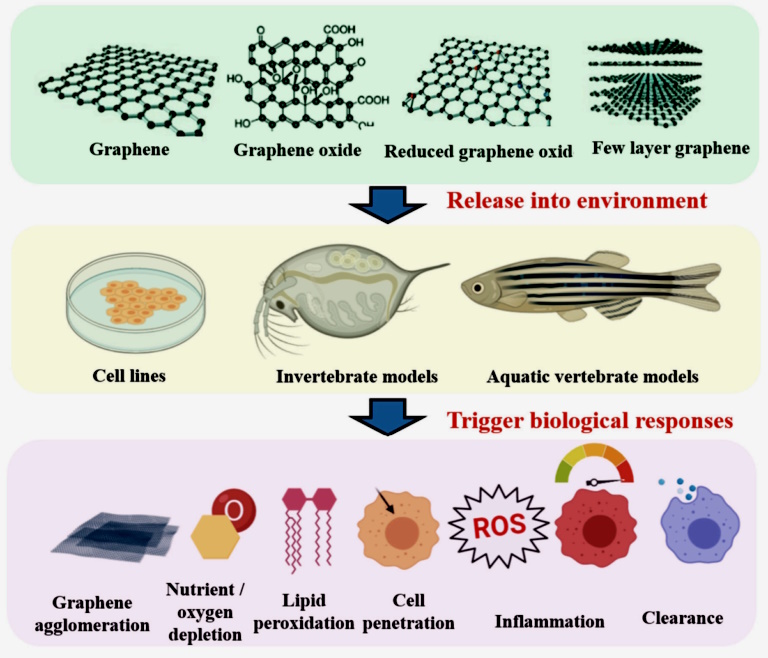
Studies on the toxicity of Graphene derivatives on all elements of aquatic environments
“Assessment of graphene oxide ecotoxicity at several trophic levels using aquatic microcosms”. 2020. [102]
The trophic chain was composed of a consortium of algae and bacteria as primary producers, chironomid larvae as primary consumers and decomposers while larvae of the amphibian Pleurodeles waltii constituted the secondary consumers. Monitoring of multiple ecotoxicological and ecological endpoints allowed to observe changes in bacterial communities while no toxic effects were noticed in chironomids. However, chironomids feeding behaviour changed as a consequence of GO contamination, leading to an increase in leaf litter consumption. Genotoxic effects were noticed in Pleurodeles larvae. This study highlights the importance of using such experimental systems to better encompass the ecotoxic potential of GO through the determination of toxicological routes and consequences on ecosystem’s functioning.
Effects of environmental factors on graphene oxide ecotoxicity towards crustacean Daphnia magna”. 2018. [121]
“Acute toxicity assessment of polyaniline/Ag nanoparticles/graphene oxide quantum dots on Cypridopsis vidua and Artemia salina”. 2021. [125]
“The effects of humic acid on the toxicity of graphene oxide to Scenedesmus obliquus and Daphnia magna”. [88]
“Acute Toxicity of Graphene to Water Flea, Brine Shrimp and Zebrafish”. 2016. In order to understand the potential ecotoxicity of Graphene released into aquatic environment, the toxicities of two types of this material were assessed using two freshwater (Daphnia magna and Danio rerio) and one saltwater (Artemia franciscana) organism. [103]
“Fast Identification and Quantification of Graphene Oxide in Aqueous Environment by Raman Spectroscopy”. 2020. [40]
GO was chemically reduced by hydrazine hydrate to form partially reduced GO (PRGO), where the fluorescence from GO was largely reduced, and the Raman signals (G band and D band) were dominating. According to the Raman characteristics, GO was easily be distinguished from other carbon nanomaterials in aqueous environments, such as carbon nanotubes, fullerene and carbon nanoparticles.
“Carbon and Metal Quantum Dots toxicity on the microalgae Chlorella pyrenoidosa”. 2016. [68]
“Toxicity of microwave-synthesized silver-reduced graphene oxide nanocomposites to the microalga Chlorella vulgaris: Comparison with the hydrothermal method synthesized counterparts”. 2020. Cette étude porte sur les effets toxiques des nano-composites d’oxyde de graphène réduit à l’argent synthétisés par micro-ondes sur l’algue Chlorella vulgaris. [92]
Moreover, reduction in the phenol and flavonoid contents, enhancement of H2O2 content, changes in the antioxidant enzymes activity and decreases in the growth parameters as well as photosynthetic pigments quantities confirmed the toxicity of MS-Ag-rGO to the C. vulgaris cells.
“The toxicity of graphene oxide affected by algal physiological characteristics: A comparative study in cyanobacterial, green algae, diatom”. 2019. This study investigates the toxicity of graphene oxide to green algae (Chlorella vulgaris, Scenedesmus obliquus, Chlamydomonas reinhardtii), cyanobacteria (Microcystis aeruginosa) and diatoms (Cyclotella sp.). The objective was to evaluate how the physiological characteristics of the algae affect the toxicity of graphene oxide. [47]
Meanwhile, growth inhibition and cell division were significantly correlated with the oxidative stress and membrane permeability, suggesting the latter two indicators can effectively signal GO toxicity to algae. The findings of this study provide novel insights into the toxicity of graphene materials in aquatic environments.
“Toxicity Studies on Graphene-Based Nanomaterials in Aquatic Organisms: Current Understanding”. 2020. This study focuses on the toxic effects of graphene and graphene oxide on aquatic invertebrates and fish (cell lines and organisms). [28]
“Effects of graphene oxide nanosheets in the polychaete Hediste diversicolor: Behavioural, physiological and biochemical responses”. 2022. This study focuses on evaluating the effects of different concentrations of graphene oxide nanosheets on the behavior, feeding activity, mucus production, regeneration capacity, antioxidant status, biochemical damage, and metabolism of the Hediste diversicolor worm. [32]
Numerous applications exist for graphene-based materials, such as graphene oxide (GO) nanosheets. Increased concentrations of GO nanosheets in the environment have the potential to have a large negative effect on the aquatic environment, with consequences for benthic organisms, such as polychaetes. The polychaete Hediste diversicolor mobilises the sediments, hence altering the availability of contaminants and the nutrients biogeochemical cycle. As such, this study proposes to assess the effects of different GO nanosheet concentrations on the behaviour, feeding activity, mucus production, regenerative capacity, antioxidant status, biochemical damage and metabolism of H. diversicolor. This study evidenced that H. diversicolor exposed to GO nanosheets had a significantly lower ability to regenerate their bodies, took longer to feed and burrow into the sediment and produced more mucus.
“Humic acids alleviate the toxicity of reduced graphene oxide modified by nanosized palladium in microalgae”. 2022. [41]
“Toxicological effects resulting from co-exposure to nanomaterials and to a β-blocker pharmaceutical drug in the non-target macrophyte species Lemna minor”. 2023. [37]
“The cytotoxicity of nano- and micro-sized graphene oxides on microalgae depends on the characteristics of cell wall and flagella”. 2023.This study investigates the cytotoxicity of nanosized and microsized graphene oxide on microalgae depends on the characteristics of the cell wall and flagella. [34]
The nano-sized GO inhibited the growth of cell wall-deficient strains and reduced the photosynthetic activity. The micro-sized GO inhibited the growth of all strains, but the inhibition efficiency was higher in flagella-deficient strains, indicating that cell wall and flagella have different roles in response to contaminant exposure. The electron microscopy analysis demonstrated that nano-sized GO caused the cell rupture in cell wall-deficient strains. In flagella-deficient strains, the nano- and micro-sized GOs were parallelly attached on the surface of cells, covering the cells. The wrapping of flagella-deficient cells by GO led to the increase of reactive oxygen species (ROS) contents. These results indicate main cytotoxic mechanism of nano-sized GO was the membrane damage of cells, and the presence of cell wall can protect the cells from the attack of nano-sized GO. On the one hand, the presence of flagella might help to avoid the attachment of GO while the cell proliferation and photosynthesis were inhibited in flagella-deficient cells due to the GO wrapping.
“Integrating FTIR 2D correlation analyses, regular and omics analyses studies on the interaction and algal toxicity mechanisms between graphene oxide and cadmium” 2022. [42]
“A trophic transfer study: accumulation of multi-walled carbon nanotubes associated to green algae in water flea Daphnia magna”. 2021. [11]
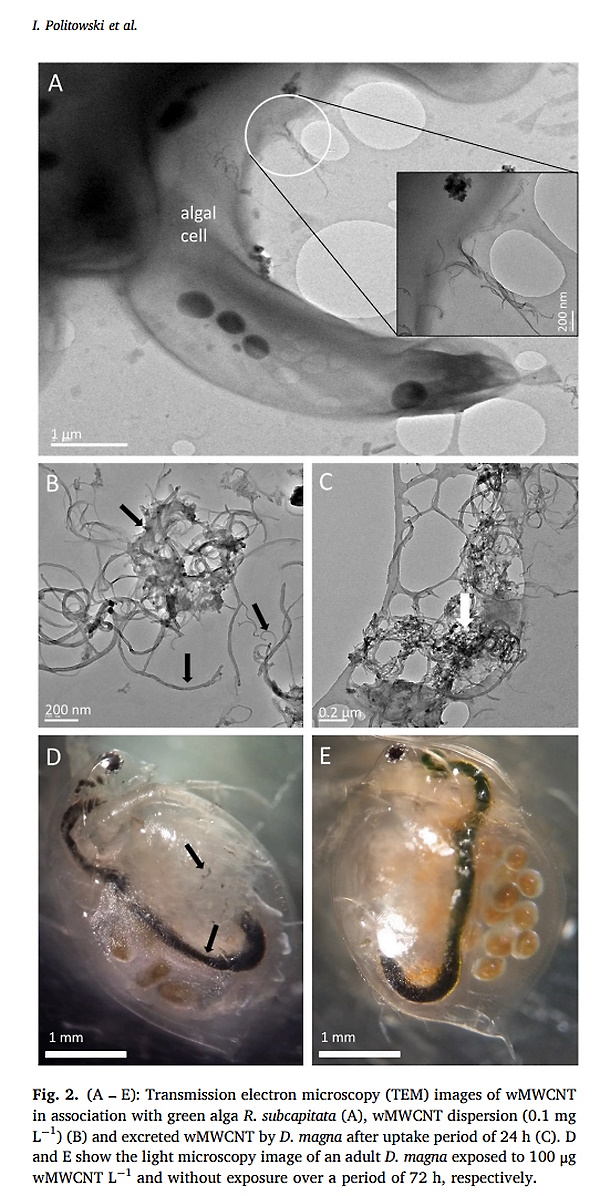
“A workflow to investigate the impacts of weathered multi-walled carbon nanotubes to the mud snail Lymnaea stagnalis”. 2021. [5]
“Colloidal Behavior and Biodegradation of Engineered Carbon-Based Nanomaterials in Aquatic Environment”. 2022. This review focuses on the current knowledge regarding the colloidal behavior, transformation, and biodegradation of different types of CNMs, including graphene and graphene-like materials, carbon nanotubes, fullerenes, and carbon quantum dots. The other part of this work presents an overview of the known mechanisms of CNM biodegradation and discusses current research related to CNM biodegradation in aquatic species. [14]
“Interactions between multi-walled carbon nanotubes and plankton as detected by Raman spectroscopy”. 2022. [44]
Studies on the ability of Graphene derivatives to allegedly improve plant growth
“Multi-walled carbon nanotubes promote the accumulation, distribution, and assimilation of 15N-KNO3 in Malus hupehensis by entering the roots”. Mars 2023. Cette étude porte sur l’impact des nano-tubes de carbone à multiples parois sur l’utilisation de l’azote chez les pommiers. [85]
“Graphene: A new technology for agriculture”. 2021. This study focuses on a review of the use of graphene in different segments, explaining that this product can be used in various industrial sectors. These are mainly in agriculture (such as in major crops of great importance, such as coffee), the food industry and the environment, as a plant growth stimulator and in fertilizers, nano-encapsulation and smart release systems, antifungal and antibacterial agents, smart packaging, water treatment and ultrafiltration, contaminant removal, pesticide and insecticide quantification, detection systems and precision agriculture. [90]
“Opportunities for graphene, single-walled and multi-walled carbon nanotube applications in agriculture: A review”. 2022. [66]
“Fluorescent carbon-dots enhance light harvesting and photosynthesis by overexpressing PsbP and PsiK genes”. 2021. This study focuses on enhancing light harvesting and photosynthesis by overexpressing PsbP and PsiK genes with fluorescent carbon quantum dots. [73]
“Enhanced Biological Photosynthetic Efficiency Using Light-Harvesting Engineering with Dual-Emissive Carbon Dots”. 2018. This study focuses on improving the efficiency of biological photosynthesis through light harvesting engineering with dual-emitting carbon quantum dots. [64]
Note this novel concept of using graphene derivatives to augment « sunlight harvesting » processes… and thus, photosynthesis.
“Carbon dots as light converter for plant photosynthesis: Augmenting light coverage and quantum yield effect”. 2021. This study focuses on carbon quantum dots as light converters for plant photosynthesis, inducing an increase in light coverage and a quantum yield effect. [65]
“Biofertilizers and nanofertilizers for sustainable agriculture: Phytoprospects and challenges.” 2022. This study focuses on bio-fertilizers and nano-fertilizers for sustainable agriculture. [63]
“Carbon-Based Nanomaterials for Sustainable Agriculture: Their Application as Light Converters, Nanosensors, and Delivery”. 2022. This study focuses on the different types of carbon-based nano-materials and their applications in light converters, nano-sensors and delivery tools in sustainable agriculture. [61]
“Vital roles of sustainable nano-fertilizers in improving plant quality and quantity-an updated review”. 2021. This study focuses on the vital roles of sustainable nano-fertilizers in improving plant quality and quantity. [89]
It should be noted that, according to some studies, this would be “sustainable agriculture”… but, according to field ecologists, what is sustainable is, rather, the graphene derivatives that self-accumulate in soils, terrestrial and aquatic environments – and that toxify them.
“Nanocarbon fertilizers: Implications of carbon nanomaterials in sustainable agriculture production”. 2020. This study focuses on the interactions of carbon-based nano-materials such as fullerene, carbon nanotubes, carbon quantum dots, carbon cone dots and graphene with agricultural plants for sustainable agriculture. [62]
Carbon nanofertilizers have shown their role in the improvement in seed germination, seedling growth, shoot-root length enhancement, enhancement of chlorophyll content and photosynthesis rate, and plant biomass increment in various cereals and horticultural crops. The transportation of carbon-based nanomaterials is illustrated in plants and how their accumulation causes phytotoxicity is explained. Further, the potential of carbon nanomaterials in agriculture is also discussed for commercial production of nanocarbon as fertilizer. Some of the carbon-based nanomaterials showed phytotoxicity after a certain high concentration level, but there is more research required to optimize the threshold concentration for each crop‑carbon nanomaterial model where maximum growth and production can be obtained.
“Graphene oxide exhibited positive effects on the growth of Aloe vera”. 2021. This study focuses on increasing the growth of Aloe Vera by adding graphene oxide nanoparticles to irrigation water – at 50 mg per liter. [1608]
“This new technology is called « bionic strategy for plant growth acceleration by injection of nanoparticles”.
“Chitosan and Graphene Oxide Nanocomposites as Coatings for Controlled-Release Fertilizer”. 2019. [938]
“Effects of graphene on morphology, microstructure and transcriptomic profiling of Pinus tabuliformis roots”. 2021. This study focuses on increasing the growth of Chinese Red Pine (Pinus tabuliformis) by adding graphene oxide nanoparticles to the irrigation water – at 25 mg per liter. [1610]
Notwithstanding these positive effects, it is reported that graphene may be detrimental to plants under certain conditions. The sharp edges of graphene may physically cut cell membranes and compromise their integrity [18]. In addition to increasing the uptake of water and fertilizer by roots, graphene also increased the uptake of heavy metals such as cadmium and arsenic, which increased their toxic effects [19, 20]. Furthermore, graphene treatment may lead to the alteration of pH, metabolic processes, induce different degrees of oxidative damage, and cause cell death [21]. These reported negative effects underscore the necessity for further research before graphene can be applied in agroforestry.
“Novel hydrated graphene ribbon unexpectedly promotes aged seed germination and root differentiation”. 2014. [45]
“Graphene quantum dots as enhanced plant growth regulators: effects on coriander and garlic plants”. 2015. [48]
“Sulfonated graphene-induced hormesis is mediated through oxidative stress in the roots of maize seedlings”. 2016. Cette étude porte sur l’hormèse induite par le graphène sulfoné qui est médiée par le stress oxydatif dans les racines des plantules de maïs. [54]
“Graphene oxide as a water transporter promoting germination of plants in soil”. 2018. [49]
“Improvement of Commercially Valuable Traits of Industrial Crops by Application of Carbon-based Nanomaterials”. 2019. This study focuses on the biological effects of graphene and carbon nanotubes on fiber-producing species (cotton, Gossypium hirsutum) and ornamental species (Catharanthus roseus). [50]
A study was published, in 2014, entitled “Slow-release fertilizer encapsulated by graphene oxide films” [936] as well as another study, in 2017, entitled “Cogranulation of Low Rates of Graphene and Graphene Oxide with Macronutrient Fertilizers Remarkably Improves Their Physical Properties”. [937]
“Slow-release fertilizer encapsulated by graphene oxide films”. 2014. [51]
“Cogranulation of Low Rates of Graphene and Graphene Oxide with Macronutrient Fertilizers Remarkably Improves Their Physical Properties”. This study focuses on the claimed improvement of physical properties through cogranulation of low levels of graphene and graphene oxide with macronutrient fertilizers. [53]
“PVA-coated fluorescent carbon dot nanocapsules as an optical amplifier for enhanced photosynthesis of lettuce”. 2020. This study focuses on the enhancement of lettuce photosynthesis with fluorescent carbon dot nano-capsules coated with polyvinyl acetate as optical enhancer. [71]
“Magnesium-nitrogen co-doped carbon dots enhance plant growth through multifunctional regulation in photosynthesis”. 2021. This study focuses on enhancing plant growth through multifunctional regulation of photosynthesis by magnesium and nitrogen codoped carbon dots. [72]
“Transfer, transportation, and accumulation of cerium-doped carbon quantum dots: Promoting growth and development in wheat”. 2021. This study investigates the transfer, transport and accumulation of cerium-doped carbon quantum dots to allegedly promote wheat growth and development. [23]
“Graphene Oxide-Assisted Promotion of Plant Growth and Stability”. 2020. This study focuses on graphene oxide to increase the growth of plants – such as watermelon. [29]
We showed that with an appropriate amount provided, graphene oxide had a positive effect on plant growth in terms of increasing the length of roots, the area of leaves, the number of leaves, and the formation of flower buds. In addition, graphene oxide affected the watermelon ripeness, increasing the perimeter and sugar content of the fruit. We believe that graphene oxide may be used as a strategy for enabling the acceleration of both plant growth and the fruit ripening process.
“Graphene Oxide, a Novel Nanomaterial as Soil Water Retention Agent, Dramatically Enhances Drought Stress Tolerance in Soybean Plants”. 2022. [36]
Taken together, our findings revealed that GO could directly increase plant defense enzymes, hormone content, and the expression of drought-related genes, thereby improving the soybean’s ability to resist drought. These findings could provide new opportunities for improving drought tolerance in soybeans through effective soil water retention agents.
“Effects of Graphene Oxide on Plant Growth: A Review”. 2022. This study focuses on the effects of graphene oxide on plant growth to facilitate its safe and effective use. [33]
Several reports of graphene oxide (GO) promoting plant growth have sparked interest in its potential applications in agroforestry. However, there are still some toxicity studies that have raised concerns about the biosafety of GO. These reports show conflicting results from different perspectives, such as plant physiology, biochemistry, cytology, and molecular biology, regarding the beneficial and detrimental effects of GO on plant growth. Seemingly inconsistent studies make it difficult to effectively apply GO in agroforestry.
“Functional carbon nanodots improve soil quality and tomato tolerance in saline-alkali soils”. 2022. This study focuses on the alleged improvement of soil quality and tolerance of tomato in saline-alkaline soils using carbon quantum dots. [4]
“Carbon nanotubes can promote seed germination via seed coat penetration”. 2011. This study investigates the enhanced germination of various crops using single-walled carbon nano-tubes: Capsicum annuum, Salvia macrosiphon, Festuca arundinace… [84]
“Nanomaterials in plant protection and fertilization: current state, foreseen applications, and research priorities”. 2012. [79]
“Proceedings of a workshop on “Nanotechnology for the agricultural sector: from research to the field””. 2014. [80]
“Carbon nanomaterials: production, impact on plant development, agricultural and environmental applications”. 2016. [88]
Studies on the ability of Graphene derivatives to eliminate or mitigate, allegedly, toxicities or pests in agriculture
“Multiwall carbon nanotubes modulate paraquat toxicity in Arabidopsis thaliana”. 2018. [70]
Carbon nanotubes can be either toxic or beneficial to plant growth and can also modulate toxicity of organic contaminants through surface sorption. The complex interacting toxic effects of carbon nanotubes and organic contaminants in plants have received little attention in the literature to date. In this study, the toxicity of multiwall carbon nanotubes (MWCNT, 50 mg/L) and paraquat (MV, 0.82 mg/L), separately or in combination, were evaluated at the physiological and the proteomic level in Arabidopsis thaliana for 7–14 days. The results revealed that the exposure to MWCNT had no inhibitory effect on the growth of shoots and leaves.
“Whole-Transcriptome Responses to Environmental Stresses in Agricultural Crops Treated with Carbon-Based Nanomaterials”. 2021. [67]
When subjected to salt stress, sorghum seedlings showed modified expression in 51 stress-related genes. The introduction of CNTs or graphene into the salty growth medium resulted in the restoration of the expression of 29 affected genes, resembling that of untreated sorghum seedlings.
“Applications of carbon quantum dots to alleviate Cd2+ phytotoxicity in Citrus maxima seedlings”. 2019. This study focuses on the purported mitigation of cadmium toxicity in grapefruit trees with carbon quantum dots – up to 900 mg/liter. [17]
“Carbon Dots as a Protective Agent Alleviating Abiotic Stress on Rice ( Oryza sativa L.) through Promoting Nutrition Assimilation and the Defense System”. 2020. This study focuses on carbon quantum dots used as a protective agent allegedly mitigating abiotic stress on rice (Oryza sativa) by promoting nutrition uptake and the defense system. [18]
“Graphene quantum dots as cysteine protease nanocarriers against stored grain insect pests”. 2020. This study focuses on the use of graphene quantum dots as cysteine protease nano-vectors, from the species Albizia procera, against, allegedly, two species of stored grain insect pests, the small mealworm, Tribolium castaneum and the grain capuchin, Rhyzopertha dominica. [19]
“Synergistic Effects of Graphene Oxide and Pesticides on Fall Armyworm, Spodoptera frugiperda”. 2022. [38]
The results showed that graphene oxide could enhance the activity of four selected pesticides: chlorantraniliprole, cypermethrin beta, methoxyhydrazide and spinetoram.
“Can the multi-walled carbon nanotubes be used to alleviate the phytotoxicity of herbicides in soils?”. 2021. [12]
Results indicate efficient alleviation of herbicide-induced phytotoxicity to rice and tobacco due to MWCNTs amendment. When 0.4% MWCNTs were applied, the concentration of sulfentrazone that inhibited the same rice height by 50% (IC50) increased to more than 3 times that of pure soil. When the MWCNTs were used to alleviate the phytotoxicity of quinclorac to tobacco, the MWCNTs not only alleviated the phytotoxicity of quinclorac but also promoted the growth of tobacco. The MWCNTs amended soil significantly increased the adsorption of herbicide to soil than biochar. The soil microbial analysis shows that MWCNTs had no significant effect on soil microbial community diversity, but the long-term exposure to MWCNTs could change the structure of the soil microbial community. Above all, our results highlighted the potential implication of the MWCNTs to ensure crop production by promoting crop growth and reducing the residual bioavailability of herbicides.
“Copper stress alleviation in corn (Zea mays): Comparative efficiency of carbon nanotubes and carbon nanoparticles”. 2022. This study investigates the comparative role of carbon nanotubes and carbon nanoparticles in maize (Zea mays) seed germination, seedling growth and Copper stress mitigation. [6]
“Multiwalled Carbon Nanotubes Alter the PSII Photochemistry, Photosystem-Related Gene Expressions, and Chloroplastic Antioxidant System in Zea mays under Copper Toxicity”. 2022. [8]
“Applications of nanomaterials in agricultural production and crop protection: a review”. 2012. [81]
“Synthesis of nanopesticides by encapsulating pesticide nanoparticles using functionalized carbon nanotubes and application of new nanocomposite for plant disease treatment”. 2014. [83]
“Evaluation and mechanism of antifungal effects of carbon nanomaterials in controlling plant fungal pathogen”. 2014. [69]
“Graphene oxide as a pesticide delivery vector for enhancing acaricidal activity against spider mites”. 2019. [74
A few Patents concerning the insertion of graphene oxide in Fertilizers and in Pesticides/Biocides of all kinds
In the agricultural field, there are already a good number of patents for the insertion of graphene oxide in fertilizers and in pesticides/biocides of all kinds, as well as for the intensification of growth processes.
There is even a patent, from 2020, entitled “Application of graphene aqueous dispersion in farmland water retention, fertilizer retention and bacteriostasis”. It is, therefore, a question of disseminating an aqueous dispersion of graphene in agricultural water retention, in fertilizer tanks… under a bacteriostatic pretext. [1112]
These patent applications date from the last few years. Here is a very partial list, out of thousands, of such patents:
“A kind of foliar fertilizer of graphene-containing nano material”. 2016 Chine. CN106747954A. [922]
“Porous oxidation graphene and preparation method thereof and porous oxidation graphene coated slow-release chemical fertilizer and preparation method thereof”. 2017. Chine. CN107585764A. [923]
“Graphene oxide and Antagonistic Fungi compound the application in terms of preventing plant Phytophthora root rot”. 2018. Chine. CN108782610A. [926]
“Water-based graphene oxide nano pesticide and preparation method and application thereof”. 2020. Chine. CN111149798A. [927]
“Graphene oxide-containing pesticide composition”. 2019. Chine. CN112293419A. [928]
“Composition for crop improvement”. 2019. Corée du sud. KR20210040597A. [929]
“Fertilizer composition of controlled release and application thereof”. Chine. CN108117437A. 2018. [75]
Connect with Dominique Guillet, Xochipelli
Cover image credit: Adrien Nicolaï/RP — Simulations by Oak Ridge National Laboratory and Rensselaer Polytechnic Institute reveal the potential of graphene oxide frameworks, pictured in black, to remove contaminants such as salt ions, seen in blue and green, from water.

